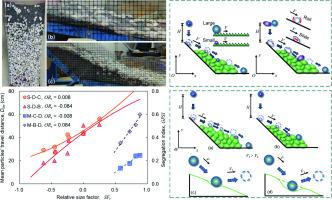碎石边坡特性的实验分析:颗粒形态的影响
IF 4.6
2区 工程技术
Q2 ENGINEERING, CHEMICAL
引用次数: 0
摘要
本研究通过一系列物理模型试验,研究颗粒形态对碎石边坡特性的影响,主要是颗粒分选和边坡角度。颗粒混合物释放试验表明,两种组成材料之间的形态差异越大,即颗粒大小和形状的差异越大,颗粒分选就越突出。分选程度随相对粒径和形状因子(SFr和ORr)的增大而增大。尺寸差异越大,坡角越小,结构越稳定;形状差异越大,坡角越大,结构越不稳定。单颗粒释放试验表明,大的、规则形状的颗粒往往传播得更远,而小的、不规则的颗粒传播得更少。与规则颗粒沉积物相比,不规则颗粒沉积物具有更高的抗冲击能力和较低的能量吸收能力,因为它们的冲击变形不太明显,从而使释放的颗粒保留更多的动能并进一步移动。从粒子运动的角度,提出了粒子形态如何影响粒子分选的概念模型。颗粒形态对坡角的影响通过对堆积状态和沉积颗粒互锁的影响进一步解释。最后,通过相对流动性的新概念(定义为组分之间的休止角之比),探讨了颗粒分选与最大坡角之间的关系。本文章由计算机程序翻译,如有差异,请以英文原文为准。

Experimental analysis of scree slope behaviour: The influence of particle morphology
This study conducts a series of physical model tests to investigate the effect of particle morphology on the scree slope characteristics which mainly refer to the particle sorting and slope angle. Granular-mixture release tests show that the greater the morphological disparity — i.e., the differences in particle size and shape—between two constituent materials, the more prominent the particle sorting becomes. The sorting degree increases with the relative particle size and shape factors (SFr and ORr). A larger size disparity tends to result in a smaller slope angle and a more stable structure, while a greater shape discrepancy leads to a larger slope angle and a less stable structure. Single-particle release tests indicate that large, regular-shaped particles tend to travel farther, whereas small, irregular ones travel less. Compared to deposits of regular-shaped particles, deposits of irregular-shaped particles exhibit a higher resistance to impact and a lower energy absorption capacity due to a less notable impact deformation, allowing released particles to retain more kinetic energy and move further. Conceptual models are proposed to illustrate how particle morphology influences particle sorting from the perspective of particle motion. The influence of particle morphology on slope angle is further explained through its effect on the packing state and interlocking of deposited particles. Finally, a correlation between particle sorting and maximum slope angle is explored via a new concept of relative flowability, defined as the ratio of the angle of repose between constituent materials.
求助全文
通过发布文献求助,成功后即可免费获取论文全文。
去求助
来源期刊

Powder Technology
工程技术-工程:化工
CiteScore
9.90
自引率
15.40%
发文量
1047
审稿时长
46 days
期刊介绍:
Powder Technology is an International Journal on the Science and Technology of Wet and Dry Particulate Systems. Powder Technology publishes papers on all aspects of the formation of particles and their characterisation and on the study of systems containing particulate solids. No limitation is imposed on the size of the particles, which may range from nanometre scale, as in pigments or aerosols, to that of mined or quarried materials. The following list of topics is not intended to be comprehensive, but rather to indicate typical subjects which fall within the scope of the journal's interests:
Formation and synthesis of particles by precipitation and other methods.
Modification of particles by agglomeration, coating, comminution and attrition.
Characterisation of the size, shape, surface area, pore structure and strength of particles and agglomerates (including the origins and effects of inter particle forces).
Packing, failure, flow and permeability of assemblies of particles.
Particle-particle interactions and suspension rheology.
Handling and processing operations such as slurry flow, fluidization, pneumatic conveying.
Interactions between particles and their environment, including delivery of particulate products to the body.
Applications of particle technology in production of pharmaceuticals, chemicals, foods, pigments, structural, and functional materials and in environmental and energy related matters.
For materials-oriented contributions we are looking for articles revealing the effect of particle/powder characteristics (size, morphology and composition, in that order) on material performance or functionality and, ideally, comparison to any industrial standard.
 求助内容:
求助内容: 应助结果提醒方式:
应助结果提醒方式:


